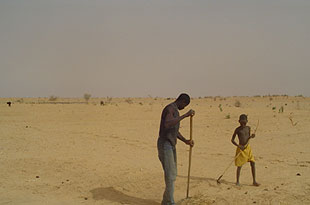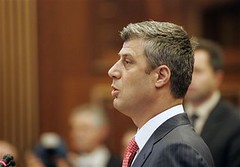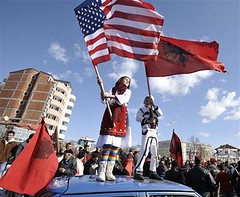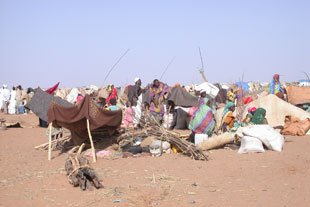News: An Alternative for Famine: Get an Insurance!
By Jeffrey Bartholet
 A U.N. agency has come up with a radical new idea to pre-empt drought-related famines: insurance.
A U.N. agency has come up with a radical new idea to pre-empt drought-related famines: insurance.Famines generally follow a grim script: first the rains fail, then aid agencies issue dire warnings, and finally the United Nations scrambles to raise money and send food aid as journalists write stories of horror and tragedy. In the worst cases, real alarms don't go off until the starving appear on television screens. Even when peasants are spared death, they often lose everything they own—including animals and seeds.
Does it have to unfold like this? The World Food Programme is trying a radical new idea: famine insurance. In this approach, a country secures an insurance policy against a catastrophic drought. If the rains come, the insurance company keeps its premium. But if rains fail and disaster is sure to strike, the international insurer pays out well before people go hungry. Richard Wilcox, director of business planning for the U.N. World Food Programme, hatched the idea in a pilot program for Ethiopia last fall. Now he's planning to enlarge the experiment. He spoke to NEWSWEEK's Jeffrey Bartholet in Washington. Excerpts:
NEWSWEEK: A mutual acquaintance refers to you as the "guru of famine insurance."
Richard Wilcox: There have been weather contracts used in different areas—primarily in the energy business, but also in agriculture in developed countries—for the past decade. Our contribution was to say that this is a tool that can work in development.
Can you tell me about the pilot program?
We ran the first pilot in Ethiopia. We chose Ethiopia, which is the most complicated country in sub-Saharan Africa to do food security…
I'd think that Somalia would be far more complicated.
Well, let's say a country that has a government. All we wanted to do was to build contingency funding for a catastrophic year. The easiest way is to ask a donor to set aside funds. But countries don't want to set aside contingency funds of significant magnitude just to have them sit there. So we translated the potential losses [for Ethiopian peasants] into an index that correlates with rainfall, took all of that data and sent it out to the international reinsurance market—eight large reinsurers that had both the credit rating and experience in the precipitation markets to be interested in this kind of work. We got six responses, and a French company called AXA Re won that first contract.
A premium of $930,000 to get coverage of $7 million?
Yes, $7.8 million
Who paid the premium?
The United States paid 90 percent of it, and a European donor, Denmark, paid 10 percent.
Why did they do it?
It was meant to have a demonstration effect—to show that these kinds of contracts can be done. To get the attention of the financial markets, as well as the aid business.
Did it succeed?
Oh, I think it has. We're going for a second phase in Ethiopia, which is moving beyond having coverage just for the catastrophic years. The coverage we're developing now is for a three-year drought-protection scheme that also covers pastoralist areas, which is technically quite challenging, but I think we've cracked that nut.
In the pilot, the drought didn't come and the insurer got to keep the premium?
Right.
Correct me if I'm wrong in my understanding of pastoral coverage: this is to protect against the depletion of forage for grazing. If there is not enough forage, contingency funds will kick in to help the herders?
That's the idea, right.
Now, if the pastoralists get money when they overgraze, won't that encourage overgrazing and the further destruction of the environment, perhaps to the point where no one will want to insure them?
The way this works, it is triggered only by objective conditions on the ground. In the absence of rainfall, there is less grass to graze on. [But] we're trying to figure out what kind of intervention is appropriate. I don't have a happy answer on what exactly a contingency plan would look like.
 To what extent is climate change driving this idea?
To what extent is climate change driving this idea?It's one of the big drivers. There are three reasons we're constructing this whole system: one is the increasing cost of destitution with growing populations. Ethiopia today has about 70 million people; by 2030 it's projected to go up to 130 or 140 million.
Now, as long as dependence on rainfall continues and rainfall is volatile, the cost of intervening to save lives and livelihoods grows significantly. The second factor is dignity for the beneficiaries. In the system as it exists now, we essentially advertise misery to raise funds—showing people's lives at their worst in order to sell our interventions. What we want to do instead is protect people's potential—to say, yes, these are productive people who have a future and need protection from weather shocks. It's very different approach. The third big factor in this is climate change.
There is a consensus that, yes, the climate is changing. What exactly that will mean for a country like Ethiopia is still unclear. But conceivably, you'll have conditions worsening, populations growing and the price tag becoming unmanageable. We need to design a system that is as cost-effective as possible.
That's where the insurers come in?
What's important about involving the international risk markets is that a lot of the expertise on climate change resides there. The people who are spending most to research climate change are the big reinsurance companies. That is their business. And we can't go to them and say, "Out of the goodness of your hearts and your sense of social responsibility, we want you to look at the climate in Ethiopia."
Are there other schemes being considered for weather insurance in the developing world?
We'd like to do coverage for much of sub-Saharan Africa. The risk cycle in Africa is the same every year: it starts with the cyclone season in Madagascar [and] Mozambique, then it's the harvest failure or flood, depending on how things go in southern Africa, then the same in the Sahel area and then the harvest cycle hits the Horn of Africa. So we'd like those risk exposures built into one big portfolio for sub-Saharan Africa. With that you could optimize the financing of it significantly.
How many countries in Africa would have the necessary data? Even in Ethiopia, who monitors the rainfall stations?
The way it works in Ethiopia is that there's a third party that is the verifier, an American company based in Maryland. It's the same company that does all rainfall verification for commercial contracts in the U.S.
Is it all drought insurance, or is there flood insurance as well?
Flood insurance is doable, seismic risk is doable, cyclone risk is doable. Seismic risk and cyclone risk are easy, because they don't require local data. Our problem in spreading this wider is not on the technical side, but government interest and donors. When we started this work, we were taken to task for exceeding the mandate of the organization.
Is there insurance to cover you for bad bureaucracy?
[Laughs]
Did you think up this idea yourself? Were you sitting around one day and thinking, hey, what about using international financial mechanisms to address the risk of drought in the developing world?
The idea came from a discussion of what is this organization, what do we do? Are we just a logistics provider? On one level that is what the organization does. But what is our function from the viewpoint of the beneficiary? Well, from their viewpoint, we are in fact an insurance provider. We step in when there are significant losses. That was the logic behind this work.
Are there people within the organization who don't want you to be an insurance provider?
It's within the organization itself, and within the governing structure. And, in a way, it's for good reason. Nobody has given WFP a mandate [for this]. A number of donors think this is interesting, but perhaps somebody else should be doing it.
Yet you've been able to launch a three-year program.
We're planning the three-year program, and we're obliged to report back to our board in November with a proposal for the appropriate institutional setting for this type of work.
Is there a nemesis? Somebody trying to kill the idea?
Different donors have reacted with different levels of enthusiasm. The U.S. has been the strongest supporter. Others have asked if this is appropriate. Spending money that is meant to help poor people on contracts with major international financial houses strikes a number of aid agencies as being wrong. Then our argument is: we are not pushing insurance per se. If donors want to have contingency money just sitting in escrow accounts, fine.






























 Peter. Flemish, European, aid worker, expeditioner, sailor, traveller, husband, father, friend, nutcase. Not necessarily in that order.
Peter. Flemish, European, aid worker, expeditioner, sailor, traveller, husband, father, friend, nutcase. Not necessarily in that order.
The Road's Dashboard
Log in
New
Edit
Customize
Dashboard